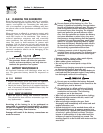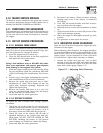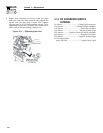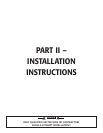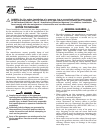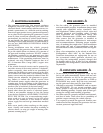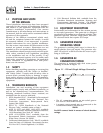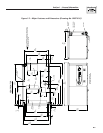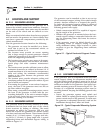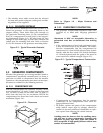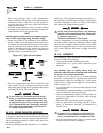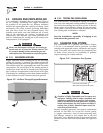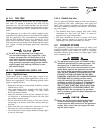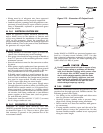
22
2.1 LOCATION AND SUPPORT
2.1.1 GENERATOR LOCATION
The most desirable location for the generator set is
between the vehicle's main frame members. However,
this is seldom possible. Most units must be installed
on the side of the vehicle and are difficult to rein-
force.
Many recreational vehicles have been factory equipped
with an area for the generator set. Some vehicles may
even have a generator compartment provided by the
vehicle manufacturer.
Plan the generator location based on the following:
• The generator set must be installed on a frame-
work that is part of the recreational vehicle, as
outlined in Section 2.1.2.
• The location must provide an access opening
that is large enough to permit generator removal
(unless the generator is to be removed from under-
neath the supporting framework).
• The location must provide easy access to frequent-
ly serviced components, such as filters, oil drains,
spark plugs and other common maintenance
parts.
• The location must provide sufficient room to allow
minimum clearances as outlined in Section 2.2. If
sound insulation is to be used on the compartment
walls and ceiling, the minimum recommended
applies to the space between the generator and
such insulation.
• The location must provide adequate cooling and
ventilating airflow for the generator without a great
deal of work and expense.
• If mounting the generator in an enclosed compart-
ment, the base of the generator must rest flat on
the floor without any gaps.
• When using a suspended mounting system, ensure
the base of the generator is flush with the sur-
rounding bodywork. If the unit is mounted higher
in the structure, heated air may recirculate into the
generator causing it to overheat.
2.1.2 GENERATOR SUPPORT
The generator must be securely attached to a metal
framework that has been made part of the vehicle
frame structure by bolting or welding. The metal
framework on which the generator will rest and
which will restrain the generator set should consist
of at least two horizontal beams. These beams should
consist of (a) 1-1/2-inch square, 11-gauge steel tub-
ing OR (b) 1-1/2-inch, 11-gauge angle iron. A typical
supporting frame with horizontal support tubing, is
shown in Figure 2.1.
The generator can be installed so that it sits on top
of the horizontal support tubing if the vehicle design
permits. Another method is to suspend the genera-
tor below the horizontal support tubing by means of
suitable, structurally sound metal framework. The
following general rules apply:
• Vehicle construction MUST be capable of support-
ing the weight of the generator.
• Whether the generator is mounted above the hori-
zontal support tubing or suspended below the tub-
ing, the supporting frame used must be structur-
ally sound.
• If the generator cannot be bolted directly to the
supporting frame or support tubing, consider
using additional tubing, angle brackets or other
supports to give the supporting frame sufficient
strength.
Figure 2.1 – Typical Horizontal Support Frame
2.1.3 SUSPENDED MOUNTING
If the generator will be suspended below the hori-
zontal support tubing, the suspension method used
with the vehicle frame members must (a) be able to
support the weight of the generator AND (b) provide
sufficient restraint for the generator. One typical sus-
pended mounting system is shown in Figure 2.2. The
location of a suspended mounting system must be
carefully planned, keeping the following general rules
in mind:
• Protect the generator against road splash and
debris. Baffles or splash guards may be required to
protect certain areas of the generator. To make sure
the generator is adequately protected, road test the
installation through mud, water and slush.
Figure 2.2 – Typical Suspended Mounting System
GENERATOR
SUPPORT FRAME
(MODEL 004718-0)
GENERATOR MOUNTING
HOLES FOR 5/16" - 18
BOLTS (6 PLACES)
Section 2 – Installation
Recreational Vehicle Generator



